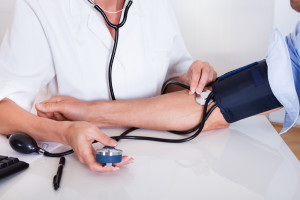The physician comes to the diagnosis of high blood pressure by taking the blood pressure on several occasions.
It is good practice to take the blood pressure in the beginning and at the end of a visit to the doctor. Anxiety can raise blood pressure considerably, but this wears off contrary to significant hypertension, which does not subside. It is also a good practice to check the blood pressure again on two more occasions before diagnosing hypertension.
This will minimize a false positive diagnosis of hypertension. The patient should be told to refrain from drinking alcoholic beverages, as this can sometimes give false high blood pressure readings.
When the blood pressure is taken, the arm circumference and the cuff size have to be matched. (Most blood pressure cuffs have the size printed on them). If the readings on three different days all measure higher than 120/80, according to Ref. 1 to 4 it is established that the person has hypertension. Children and infants have much lower blood pressures than adults and need special pediatric cuffs to measure.
Once the diagnosis of hypertension has been made, it is important to exclude secondary hypertension as these would include some treatable conditions. Some of the further test would include blood tests to check for kidney function, electrolytes, blood sugar, cholesterol and lipoproteins. An ECG should be obtained to check for myocardial hypertrophy. If the patient is younger or if the blood pressure is very high, then a more thorough testing needs to be done to rule out a pheochromocytoma (hormone producing tumor of the adrenal gland). About 1 in 1000 people with hypertension have a pheochromocytoma, which is mostly not malignant. It occurs in the age group between 20 and 50. Surgery will cure this type of hypertension. Other tests would be done in the younger age group such as chest x-ray, renal nuclear medicine scan (scintigraphy).
Examining the blood vessels of the back of the eye with the ophthalmoscope (fundoscopy) is another important aspect of the examination. There are 4 stages of arteriosclerotic blood vessel changes (hypertensive retinopathy): 1. Constriction of retinal arteries only 2. Constriction and sclerosis of the retinal arteries. 3. Hemorrhages and exudates on top of the vascular changes. 4. Papilledema of the optic nerve with malignant hypertension. It is important to distinguish these categories as with grade I changes 70% will survive 3 years while with grade IV only 6% will survive for 3 years. It is therefore imperative that you get a referral to an ophthalmologist in the beginning when hypertension has been diagnosed, just to get a base line eye examination. This will document the state of the arteries in the body at that time. The same arteriosclerotic changes that are present in the small arteries of the eyes are also present throughout the body in the vital organs. It is important to document what the state of the arteries was in the beginning of the treatment against hypertension so that future comparisons can be made against this initial eye examination.
References:
2. JS Trilling et al. Arch Fam Med 2000 Sep/Oct (9): 794-801.
3. DJ Hyman et al. Arch Intern Med 2000 Aug 160(15): 2281-2286.
4. CP Tifft Curr Hypertens Rep 2000 Jun (3): 243-246.
5. The Merck Manual, 7th edition, by M. H. Beers et al., Whitehouse Station, N.J., 1999. Chapter 199.
6. Noble: Textbook of Primary Care Medicine, 3rd ed.,2001, Mosby Inc.
7. Goroll: Primary Care Medicine, 4th ed., 2000, Lippincott Williams & Wilkins
8. Ferri: Ferri’s Clinical Advisor: Instant Diagnosis and Treatment, 2004 ed., Copyright © 2004 Mosby, Inc.
9. Rakel: Conn’s Current Therapy 2004, 56th ed., Copyright © 2004 Elsevier







